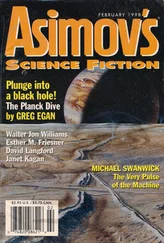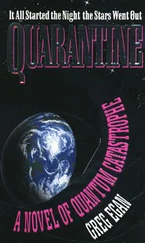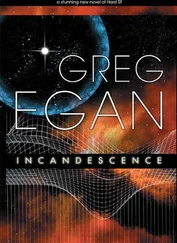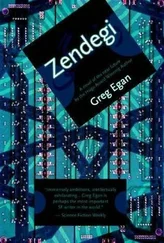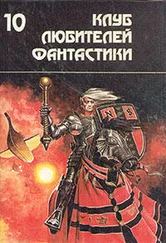Greg Egan - The Eternal Flame
Здесь есть возможность читать онлайн «Greg Egan - The Eternal Flame» весь текст электронной книги совершенно бесплатно (целиком полную версию без сокращений). В некоторых случаях можно слушать аудио, скачать через торрент в формате fb2 и присутствует краткое содержание. Жанр: Фантастика и фэнтези, на английском языке. Описание произведения, (предисловие) а так же отзывы посетителей доступны на портале библиотеки ЛибКат.
- Название:The Eternal Flame
- Автор:
- Жанр:
- Год:неизвестен
- ISBN:нет данных
- Рейтинг книги:4 / 5. Голосов: 1
-
Избранное:Добавить в избранное
- Отзывы:
-
Ваша оценка:
- 80
- 1
- 2
- 3
- 4
- 5
The Eternal Flame: краткое содержание, описание и аннотация
Предлагаем к чтению аннотацию, описание, краткое содержание или предисловие (зависит от того, что написал сам автор книги «The Eternal Flame»). Если вы не нашли необходимую информацию о книге — напишите в комментариях, мы постараемся отыскать её.
The Eternal Flame — читать онлайн бесплатно полную книгу (весь текст) целиком
Ниже представлен текст книги, разбитый по страницам. Система сохранения места последней прочитанной страницы, позволяет с удобством читать онлайн бесплатно книгу «The Eternal Flame», без необходимости каждый раз заново искать на чём Вы остановились. Поставьте закладку, и сможете в любой момент перейти на страницу, на которой закончили чтение.
Интервал:
Закладка:
A few stretches down the corridor she turned a corner and ran into her neighbor, Calogero. He was carrying a ballot box and a stack of voting papers.
“Tamara?” He stared at her. “So… the blight’s under control now?”
“It certainly is.” Blight. What else could keep every prying neighbor away until the deed was done? Tamara stood a moment, marveling at Erminio’s cunning. The worse he claimed the infestation to be, the keener the agronomists would be to investigate the aftermath—but it would only take a few burned patches in the fields to make it look as if Tamaro had eradicated the menace entirely.
Calogero was still confused, though if he’d been told that children had already been sighted he wasn’t letting on. “Is Tamaro coming out to vote?”
“He didn’t say. But there’s nothing in the farm for you to worry about,” she said.
“You’re sure of that?”
“Absolutely. The election probably slipped his mind. You should go in and get his vote.”
“All right.” Calogero put down the ballot box and offered her a paper. He said, “I know there’ll be other places on your way, but since we’re here you might as well get it over with.”
21
“Carla! I thought we’d lost you to the astronomers!”
Patrizia looked alarmingly gaunt, but she seemed to be in good spirits. Carla dragged herself across the small meeting room toward her. With all the preparations for the trip it had been more than six stints since they’d last spoken. “If Tamara had her way I’d be doing another safety drill right now,” Carla replied. “I’ve spent more time inside their fake Gnat than I ever will inside the real one.”
“Better than being unprepared,” Patrizia suggested.
“True.” Every member of the crew had made mistakes in the tethered mock-up that might well have been fatal if they’d taken place on the real flight. “But I wasn’t going to miss this for anything. ‘Demoting the Photon’? Assunto agreed that our experiments were conclusive. I can’t believe he’d turn around and attack us like this.”
“Does demotion count as an attack?” Patrizia wondered. “At least he didn’t call it ‘Forget About the Photon’.”
“You’re much too forgiving,” Carla complained. “It’ll ruin your career.”
Patrizia said, “Don’t you think we should hear him out before deciding if there’s anything to forgive?”
Carla spotted Onesto and raised a hand in greeting. As he approached she called out, “Here for more punishment?” As enchanted as Onesto was by the grand narrative of physics, he wasn’t always keen to dirty his hands with the real thing. When he’d sat in on her power series calculations for the tarnishing experiment he’d ended up moaning and clutching his head.
“Duty compels me,” he said. “Someone has to document this revolution.”
“Including every petty little backlash?” Carla replied.
Onesto was amused. “So you’re taking the title of this talk personally?”
“How else should I take it? I have to defend my one claim to immortality.”
“Wasn’t it Patrizia who posited the photon?”
“Yes, but I chose the name.”
By the time Assunto arrived the room was crowded. He placed a stack of copies of his paper in a dispenser by the doorway. Carla was hurt that he hadn’t shown it to her earlier, giving her a chance to respond. She hadn’t had the time to engage in any serious collaboration since she’d agreed to join the crew of the Gnat , but she wasn’t—yet—literally unreachable.
Assunto began, without ceremony. “The tarnishing experiments carried out by Carla and her team have given us compelling evidence that the luxagens in a solid can only occupy certain definite energy levels. These levels can be explained by treating the luxagens as standing waves, spread out across the width of their energy valleys, rather than particles with a single, definite position at every moment in time.
“Yet once they’re freed from the solid, the same luxagens scatter light in a manner suggesting that they really are particles—and that the light they scatter also consists of particles, some three times heavier than the luxagens.
“But light, undeniably, is a wave. Giorgio and Nereo showed us how to measure its wavelength from the interference pattern it makes when it passes through two or more slits. Carla and Patrizia have never sought to deny that, but they do ask us to accept that this wave is always accompanied by a suitable entourage of particles—not so much driven along with the wave by any explicable force, as bound to it by an axiom too profound and opaque to yield to any further reflection or inquiry.”
Carla tried not to grow angry; in truth, this was the weakest part of their theory. But no amount of sarcasm directed at that awkward hybrid ontology could change the evidence: light’s granular nature was every bit as plain as its wavelike properties.
“What are we to make of this?” Assunto continued. “I propose a solution that builds on the success of Patrizia’s principle. The equation governing a particle trapped in an energy valley is transformed, by that principle, into an equation for a standing wave in the same valley. Such a wave can only take on certain distinct shapes, each with its own characteristic energy.
“But if our ideas about the mechanics of a simple particle require such a radical new approach, surely we shouldn’t apply it in a piecemeal fashion? Suppose we can identify another system that appears to be governed by the very same equations that we once thought adequate to account for the motion of a particle in a valley. Shouldn’t that system be treated in exactly the same way?”
Carla had no idea what example he had in mind, but on the face of it this sounded like a reasonable proposal.
Assunto said, “Consider a light wave with a single, pure frequency, traveling in a certain direction and possessing a definite polarization. In the real world we never encounter anything so simple—but the actual waves we do find traveling through the void can always be constructed by adding together a multitude of those idealized waves.
“Because this wave has a single frequency, we can capture everything about the way it changes over time by picking one location and measuring the strength, the amplitude, of the light field at that point. This amplitude behaves very simply: it oscillates back and forth at the frequency shared by the entire wave.
“Does that remind you of anything? Such as… a particle rolling back and forth in an energy valley?”
Assunto paused, as if expecting objections, but the room was silent. Carla wanted to leap ahead of him—to complete the analogy, grasp its implications and find some fatal flaw that he had missed—but her mind seized up and the opportunity passed.
“The parallels can be made precise,” Assunto claimed. “The amplitude of our idealized light wave corresponds to the distance of a particle from the center of a one-dimensional, infinitely high, parabolic energy valley. The energy of the light wave can be broken down into two parts: one analogous to the particle’s potential energy, due only to its position in the valley, and the other analogous to its kinetic energy, which depends only on its speed.
“Carla and her team have already shown us what happens when you apply Patrizia’s principle to a particle trapped in an energy valley in a solid. Our system is actually simpler, since the valley in a solid is three-dimensional, and it’s not exactly parabolic. The simpler version of all the same calculations yields an infinite sequence of energy levels, all spaced the same distance apart.
“What determines the spacing of those energy levels? In a solid, it comes from the natural frequency of a particle rolling in the valley—so in our case, it comes from the frequency at which the amplitude of the light field oscillates back and forth. So the light wave must have an energy that belongs to a set of discrete values, and the gap between each level and the next will be equal to Patrizia’s constant times the frequency of the light.”
Читать дальшеИнтервал:
Закладка:
Похожие книги на «The Eternal Flame»
Представляем Вашему вниманию похожие книги на «The Eternal Flame» списком для выбора. Мы отобрали схожую по названию и смыслу литературу в надежде предоставить читателям больше вариантов отыскать новые, интересные, ещё непрочитанные произведения.
Обсуждение, отзывы о книге «The Eternal Flame» и просто собственные мнения читателей. Оставьте ваши комментарии, напишите, что Вы думаете о произведении, его смысле или главных героях. Укажите что конкретно понравилось, а что нет, и почему Вы так считаете.

